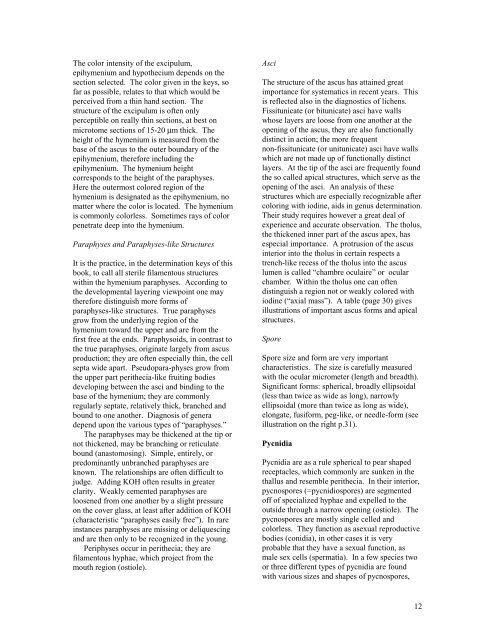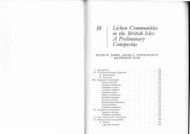Create successful ePaper yourself
Turn your PDF publications into a flip-book with our unique Google optimized e-Paper software.
The color intensity <strong>of</strong> the excipulum,<br />
epihymenium and hypothecium depends on the<br />
section selected. The color given in the keys, so<br />
far as possible, relates to that which would be<br />
perceived from a thin hand section. The<br />
structure <strong>of</strong> the excipulum is <strong>of</strong>ten only<br />
perceptible on really thin sections, at best on<br />
microtome sections <strong>of</strong> 15-20 µm thick. The<br />
height <strong>of</strong> the hymenium is measured from the<br />
base <strong>of</strong> the ascus to the outer boundary <strong>of</strong> the<br />
epihymenium, therefore including the<br />
epihymenium. The hymenium height<br />
corresponds to the height <strong>of</strong> the paraphyses.<br />
Here the outermost colored region <strong>of</strong> the<br />
hymenium is designated as the epihymenium, no<br />
matter where the color is located. The hymenium<br />
is commonly colorless. Sometimes rays <strong>of</strong> color<br />
penetrate deep into the hymenium.<br />
Paraphyses and Paraphyses-like Structures<br />
It is the practice, in the determination keys <strong>of</strong> this<br />
book, to call all sterile filamentous structures<br />
within the hymenium paraphyses. According to<br />
the developmental layering viewpoint one may<br />
therefore distinguish more forms <strong>of</strong><br />
paraphyses-like structures. True paraphyses<br />
grow from the underlying region <strong>of</strong> the<br />
hymenium toward the upper and are from the<br />
first free at the ends. Paraphysoids, in contrast to<br />
the true paraphyses, originate largely from ascus<br />
production; they are <strong>of</strong>ten especially thin, the cell<br />
septa wide apart. Pseudopara-physes grow from<br />
the upper part perithecia-like fruiting bodies<br />
developing between the asci and binding to the<br />
base <strong>of</strong> the hymenium; they are commonly<br />
regularly septate, relatively thick, branched and<br />
bound to one another. Diagnosis <strong>of</strong> genera<br />
depend upon the various types <strong>of</strong> “paraphyses.”<br />
The paraphyses may be thickened at the tip or<br />
not thickened, may be branching or reticulate<br />
bound (anastomosing). Simple, entirely, or<br />
predominantly unbranched paraphyses are<br />
known. The relationships are <strong>of</strong>ten difficult to<br />
judge. Adding KOH <strong>of</strong>ten results in greater<br />
clarity. Weakly cemented paraphyses are<br />
loosened from one another by a slight pressure<br />
on the cover glass, at least after addition <strong>of</strong> KOH<br />
(characteristic “paraphyses easily free”). In rare<br />
instances paraphyses are missing or deliquescing<br />
and are then only to be recognized in the young.<br />
Periphyses occur in perithecia; they are<br />
filamentous hyphae, which project from the<br />
mouth region (ostiole).<br />
Asci<br />
The structure <strong>of</strong> the ascus has attained great<br />
importance for systematics in recent years. This<br />
is reflected also in the diagnostics <strong>of</strong> lichens.<br />
Fissitunicate (or bitunicate) asci have walls<br />
whose layers are loose from one another at the<br />
opening <strong>of</strong> the ascus, they are also functionally<br />
distinct in action; the more frequent<br />
non-fissitunicate (or unitunicate) asci have walls<br />
which are not made up <strong>of</strong> functionally distinct<br />
layers. At the tip <strong>of</strong> the asci are frequently found<br />
the so called apical structures, which serve as the<br />
opening <strong>of</strong> the asci. An analysis <strong>of</strong> these<br />
structures which are especially recognizable after<br />
coloring with iodine, aids in genus determination.<br />
Their study requires however a great deal <strong>of</strong><br />
experience and accurate observation. The tholus,<br />
the thickened inner part <strong>of</strong> the ascus apex, has<br />
especial importance. A protrusion <strong>of</strong> the ascus<br />
interior into the tholus in certain respects a<br />
trench-like recess <strong>of</strong> the tholus into the ascus<br />
lumen is called “chambre oculaire” or ocular<br />
chamber. Within the tholus one can <strong>of</strong>ten<br />
distinguish a region not or weakly colored with<br />
iodine (“axial mass”). A table (page 30) gives<br />
illustrations <strong>of</strong> important ascus forms and apical<br />
structures.<br />
Spore<br />
Spore size and form are very important<br />
characteristics. The size is carefully measured<br />
with the ocular micrometer (length and breadth).<br />
Significant forms: spherical, broadly ellipsoidal<br />
(less than twice as wide as long), narrowly<br />
ellipsoidal (more than twice as long as wide),<br />
elongate, fusiform, peg-like, or needle-form (see<br />
illustration on the right p.31).<br />
Pycnidia<br />
Pycnidia are as a rule spherical to pear shaped<br />
receptacles, which commonly are sunken in the<br />
thallus and resemble perithecia. In their interior,<br />
pycnospores (=pycnidiospores) are segmented<br />
<strong>of</strong>f <strong>of</strong> specialized hyphae and expelled to the<br />
outside through a narrow opening (ostiole). The<br />
pycnospores are mostly single celled and<br />
colorless. They function as asexual reproductive<br />
bodies (conidia), in other cases it is very<br />
probable that they have a sexual function, as<br />
male sex cells (spermatia). In a few species two<br />
or three different types <strong>of</strong> pycnidia are found<br />
with various sizes and shapes <strong>of</strong> pycnospores,<br />
12





